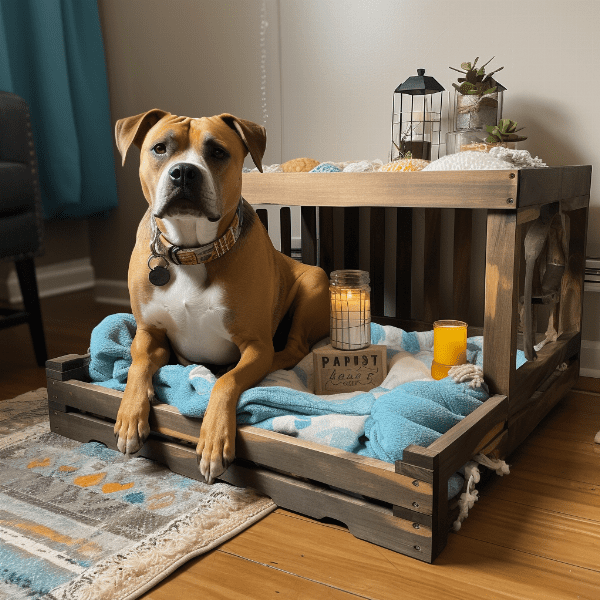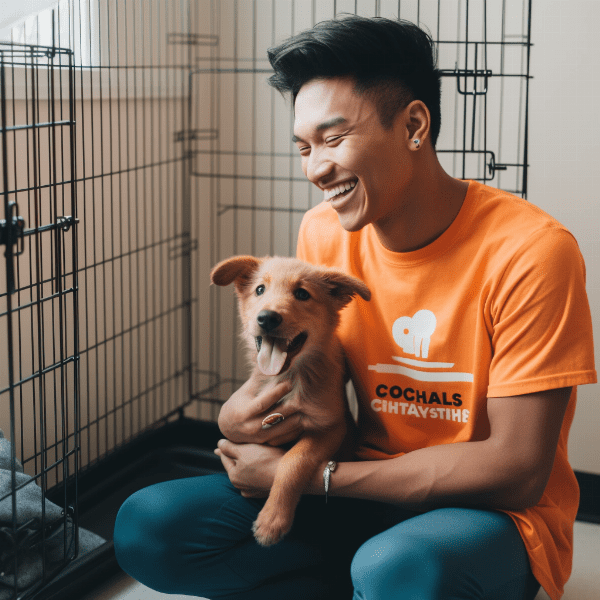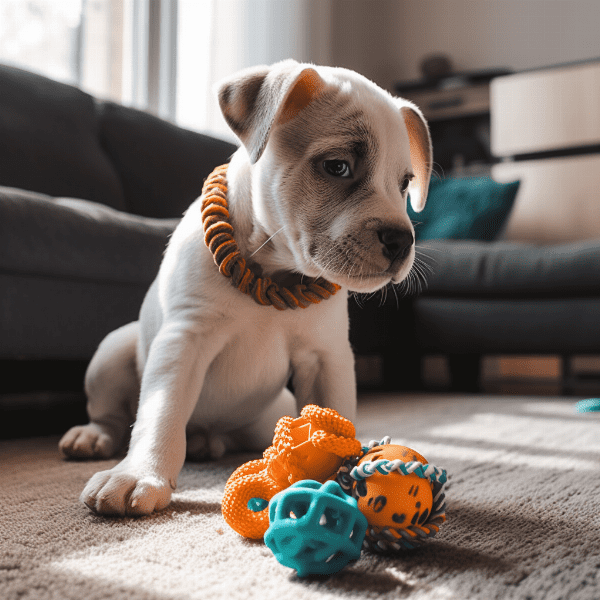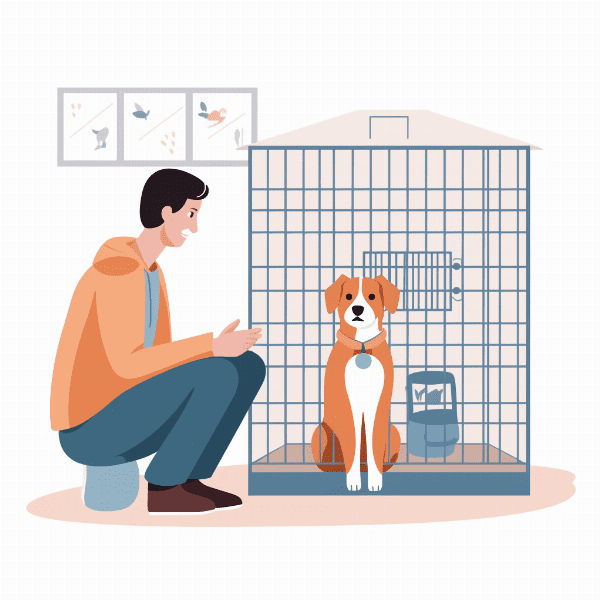Table of Contents
- Understanding Why Puppies Cry in Crates
- Preparing the Crate for a Comfortable Experience
- Gradual Crate Training for Anxiety Reduction
- Using Positive Reinforcement Techniques for Encouragement
- Providing Adequate Exercise and Mental Stimulation
- Establishing a Consistent Routine for Comfort and Security
- Incorporating Calming Scents and Sounds into the Environment
- Monitoring and Responding to Your Puppy’s Needs
- Avoiding Common Mistakes in Crate Training
- Seeking Professional Help for Persistent Crying Issues
Understanding Why Puppies Cry in Crates
Crying is a natural behavior for puppies, especially when they are left alone or placed in a new environment. When it comes to crate training, crying is a common occurrence that can make both the puppy and the owner feel stressed and overwhelmed. However, it’s important to understand why puppies cry in crates in order to address their needs effectively.
Separation Anxiety and Fear
One of the most common reasons why puppies cry in crates is separation anxiety. Puppies are social animals that crave attention and companionship, and being left alone in a confined space can trigger feelings of fear and abandonment. They may also associate the crate with negative experiences, such as being taken away from their littermates or being punished.
Physical Needs
Puppies have physical needs that require attention and care, such as hunger, thirst, and the need to eliminate. If a Puppy is crying in the crate, it’s possible that they need to go to the bathroom, have not had enough food or water, or are feeling uncomfortable due to the temperature or bedding.
Boredom and Lack of Stimulation
Puppies have boundless energy and curiosity, and if they are not provided with enough mental and physical stimulation, they can become bored and restless. A lack of toys, interactive games, and playtime can cause a puppy to cry in the crate out of frustration and pent-up energy.
Medical Issues
In some cases, a puppy’s crying in the crate may be due to underlying medical issues. Pain, illness, or discomfort can cause a puppy to be restless and cry, even when they are in a familiar and comfortable environment.
By understanding why puppies cry in crates, you can take steps to address their needs and create a positive and comfortable crate training experience for both you and your furry friend.

Preparing the Crate for a Comfortable Experience
A key factor in helping your puppy feel comfortable in their crate is to create an inviting and cozy environment that meets their physical and psychological needs. Here are some tips for preparing the crate for a comfortable experience:
Choose the Right Size
The crate should be appropriately sized for your puppy, allowing them to stand up, turn around, and lie down comfortably. If the crate is too small, your puppy may feel cramped and uncomfortable, while a crate that is too large can lead to accidents and discomfort.
Provide Comfortable Bedding
Soft, comfortable bedding can help your puppy feel cozy and secure in their crate. Choose bedding that is easy to clean and maintain, such as a washable fleece or cotton pad. Avoid using bedding that is too thick or plush, as it can create a risk for suffocation or choking.
Make it a Positive Space
Introducing your puppy to their crate as a positive space can help them feel comfortable and relaxed in it. Place treats, toys, and familiar objects in the crate to encourage your puppy to enter and explore the space. Avoid using the crate as a place for punishment or isolation.
Provide Adequate Ventilation and Lighting
The crate should be well-ventilated to prevent your puppy from feeling stuffy or overheated. It should also be located in an area that receives natural light, which can help regulate your puppy’s sleep and wake cycles.
Ensure Safety and Security
The crate should be securely fastened and placed on a stable surface to prevent it from tipping or collapsing. Remove any items that could pose a choking or suffocation hazard, such as collars or tags. Place the crate in a quiet and safe location, away from any potential hazards or distractions.
By taking the time to prepare the crate for a comfortable experience, you can help your puppy feel safe, secure, and relaxed during the crate training process.

Gradual Crate Training for Anxiety Reduction
Crate training should be a gradual process that helps your puppy feel comfortable and confident in their crate. Here are some steps to follow for gradual crate training to reduce anxiety:
Introduce the Crate Gradually
Introduce your puppy to the crate gradually by leaving the door open and allowing them to explore the space at their own pace. Encourage your puppy to enter the crate by placing treats, toys, and familiar objects inside.
Close the Door for Short Periods
Once your puppy is comfortable in the crate with the door open, start closing the door for short periods of time. Begin with just a few seconds, gradually increasing the time as your puppy becomes more comfortable.
Stay Close By
While your puppy is in the crate, stay close by and offer reassurance and encouragement. Talk to your puppy in a calm and soothing voice and provide treats and toys as positive reinforcement.
Increase the Distance
Once your puppy is comfortable with the door closed, begin to increase the distance between you and the crate. Start by moving a few steps away, then gradually increase the distance over time.
Extend the Time
As your puppy becomes more comfortable with being in the crate, gradually extend the amount of time they spend in it. Begin with just a few minutes, gradually increasing the time over several days or weeks.
Incorporate Mealtime
Incorporating mealtime into crate training can help your puppy associate the crate with positive experiences. Place your puppy’s food and water bowls inside the crate, gradually moving them closer to the back of the crate over time.
By following a gradual and patient approach to crate training, you can help your puppy feel comfortable and secure in their crate, reducing their anxiety and ensuring a positive crate training experience.

Using Positive Reinforcement Techniques for Encouragement
Positive reinforcement is a powerful tool for encouraging your puppy to feel comfortable and secure in their crate. Here are some techniques for using positive reinforcement during crate training:
Use Treats and Toys
Offering treats and toys is a simple yet effective way to reinforce positive behaviors in your puppy. Offer treats and toys as a reward for entering the crate, remaining calm and quiet, and exhibiting other desirable behaviors.
Use Verbal Praise
Verbal praise can also be a powerful form of positive reinforcement. Offer verbal praise in a calm and soothing tone of voice, such as “good puppy” or “well done”, to encourage your puppy’s positive behaviors.
Avoid Punishment
Avoid using punishment as a form of reinforcement during crate training. Punishment can create negative associations with the crate and cause your puppy to feel anxious and fearful.
Use Clicker Training
Clicker training is a form of positive reinforcement that can be used during crate training. Use a clicker to signal positive behaviors, such as entering the crate or remaining calm and quiet. Offer treats and verbal praise as a reward for the behavior.
.

Providing Adequate Exercise and Mental Stimulation
Providing your puppy with adequate exercise and mental stimulation is an important aspect of crate training. Here are some tips for ensuring your puppy gets enough exercise and mental stimulation:
Take Regular Walks
Taking regular walks with your puppy is a great way to provide them with exercise and mental stimulation. Walking not only provides physical activity, but it also exposes your puppy to new sights, sounds, and smells.
Play Interactive Games
Interactive games, such as fetch or hide-and-seek, can provide your puppy with mental stimulation and exercise. Use toys, treats, or balls to play these games with your puppy, making sure to choose activities that are appropriate for their age and physical abilities.
Rotate Toys
Rotating your puppy’s toys on a regular basis can prevent boredom and keep them engaged in their environment. Offer a variety of toys that offer different textures, sounds, and shapes to keep your puppy interested.
Use Puzzle Toys
Puzzle toys are a great way to provide your puppy with mental stimulation and exercise. These toys often require your puppy to use problem-solving skills and physical dexterity to obtain a reward, such as a treat or toy.
Train with Positive Reinforcement
Training your puppy with positive reinforcement can provide mental stimulation and encourage exercise. Use treats and verbal praise to reinforce positive behaviors, such as sitting, lying down, or coming when called.
Provide Adequate Playtime
Providing your puppy with adequate playtime is important for their physical and mental health. Set aside time each day for structured playtime, such as tug-of-war or fetch, as well as unstructured playtime, such as exploring the backyard or playing with toys.
By providing your puppy with adequate exercise and mental stimulation, you can help reduce anxiety and prevent boredom during crate training. Remember to choose activities that are appropriate for your puppy’s age, physical abilities, and temperament.

Establishing a Consistent Routine for Comfort and Security
Establishing a consistent routine is essential for creating a sense of comfort and security for your puppy during crate training. Here are some tips for creating a routine:
Set a Schedule
Set a schedule for your puppy that includes regular meal times, playtime, exercise, and crate time. Stick to the schedule consistently to establish a sense of predictability and security for your puppy.
Provide Consistent Reinforcement
Provide consistent reinforcement for positive behaviors, such as entering the crate, remaining calm and quiet, and exhibiting desirable behaviors. Use treats, toys, and verbal praise to reinforce positive behaviors consistently.
Avoid Changes to the Routine
Avoid making sudden changes to your puppy’s routine, as this can cause anxiety and confusion. If changes are necessary, make them gradually and with plenty of notice to allow your puppy time to adjust.
Keep a Consistent Environment
Keep the environment consistent and stable for your puppy. Avoid making changes to the location of the crate or the bedding, and ensure that the temperature and lighting remain consistent.
Be Patient
Crate training can take time and patience, so it’s important to be patient with your puppy as they adjust to their routine. Remember that your puppy is learning a new behavior and may need time to become comfortable and confident in their crate.
Seek Professional Help
If your puppy continues to exhibit anxiety or stress during crate training, seek professional help from a veterinarian or dog trainer. They can provide guidance and support for creating a positive and effective crate training experience.

Incorporating Calming Scents and Sounds into the Environment
Use Aromatherapy
Aromatherapy can be a powerful tool for calming your puppy’s anxiety. Lavender, chamomile, and vanilla are all scents that have been shown to have a calming effect on dogs. Use a diffuser or a spray to introduce these scents into the environment.
Play Soothing Music
Playing soothing music can also help your puppy feel more relaxed and calm. Choose music that is specifically designed for dogs or choose classical music with a slow tempo.
Use White Noise
White noise, such as a fan or a white noise machine, can create a calming and consistent background noise that can help your puppy relax and feel secure.
Use Adaptil Products
Adaptil is a product line that uses pheromones to help reduce anxiety in dogs. Adaptil products include sprays, collars, and diffusers that can be used to introduce calming pheromones into the environment.
Avoid Loud Noises
Avoid loud noises that can startle or upset your puppy, such as fireworks or thunderstorms. If your puppy is sensitive to these noises, consider using a white noise machine or Adaptil products to create a more calming environment.
Introduce Gradually
Introduce calming scents and sounds gradually to allow your puppy time to adjust to the new stimuli. Start with a low volume or a small amount of scent, gradually increasing over time.
By incorporating calming scents and sounds into your puppy’s environment, you can help them feel more relaxed and comfortable in their crate, making crate training a positive and successful experience.

Monitoring and Responding to Your Puppy’s Needs
Monitoring your puppy’s needs and responding to them appropriately is an important aspect of crate training. Here are some tips for monitoring and responding to your puppy’s needs:
Watch for Signs of Anxiety
Watch for signs of anxiety in your puppy, such as whining, panting, or pacing. If your puppy exhibits signs of anxiety, try to identify the cause and respond accordingly.
Monitor Food and Water Intake
Monitor your puppy’s food and water intake to ensure that they are receiving enough nourishment throughout the day. Offer water and food at regular intervals and adjust the amount as needed.
Provide Adequate Bathroom Breaks
Provide your puppy with adequate bathroom breaks to prevent accidents in the crate. Puppies may need to go to the bathroom every 1-2 hours, so plan to take them outside at regular intervals.
Respond to Whining Appropriately
If your puppy whines in the crate, respond appropriately. Avoid giving attention or treats for whining, as this can reinforce the behavior. Instead, wait until your puppy is calm and quiet before offering positive reinforcement.
Offer Affection and Reassurance
Offer your puppy affection and reassurance during the crate training process. Provide verbal praise, pets, and cuddles as positive reinforcement for positive behaviors.
Adjust the Crate or Routine as Needed
If your puppy continues to exhibit anxiety or stress during crate training, consider adjusting the crate or routine to better meet their needs. This may include adjusting the size of the crate, offering more exercise and mental stimulation, or adjusting the routine to better suit your puppy’s temperament.
By monitoring and responding to your puppy’s needs, you can ensure that they feel comfortable and secure during the crate training process. Remember to be patient and consistent with your training techniques, and seek professional help if needed.

Avoiding Common Mistakes in Crate Training
Crate training can be a complex process, and there are many common mistakes that can be made. Here are some tips for avoiding common mistakes in crate training:
Avoid Using the Crate as Punishment
Using the crate as punishment can create negative associations with the crate and cause your puppy to feel anxious and fearful. Avoid using the crate as a form of punishment, and instead use positive reinforcement techniques to encourage your puppy to feel comfortable and secure in their crate.
Avoid Leaving Your Puppy in the Crate for Extended Periods
Leaving your puppy in the crate for extended periods can cause them to feel anxious and stressed. Puppies should not be left in the crate for more than a few hours at a time, and should have access to regular bathroom breaks, exercise, and mental stimulation.
Avoid Using the Crate for Too Long Too Soon
Introducing the crate too quickly or for too long can cause your puppy to feel overwhelmed and anxious. Gradually introduce the crate, starting with short periods of time, and gradually increasing the length of time over several days or weeks.
Avoid Neglecting Exercise and Mental Stimulation
Neglecting exercise and mental stimulation can cause your puppy to feel bored and anxious, which can lead to negative behaviors in the crate. Make sure to provide adequate exercise and mental stimulation, both inside and outside of the crate.
Avoid Neglecting Your Puppy’s Needs
Neglecting your puppy’s needs, such as food, water, and bathroom breaks, can cause them to feel anxious and stressed. Make sure to monitor your puppy’s needs and respond appropriately to ensure their comfort and well-being.
Avoid Rushing the Process
Rushing the crate training process can lead to negative associations with the crate and cause your puppy to feel anxious and fearful. Take the time to follow a gradual and patient approach to crate training, and seek professional help if needed.
By avoiding common mistakes in crate training, you can ensure that your puppy feels comfortable and secure in their crate, making crate training a positive and successful experience.

Seeking Professional Help for Persistent Crying Issues
While crate training can be effective for many puppies, some may experience persistent crying or anxiety issues that require professional help. Here are some signs that your puppy may need professional help and tips for seeking assistance:
Signs Your Puppy May Need Professional Help
Persistent crying, destructive behavior, and signs of extreme anxiety or stress are all signs that your puppy may need professional help with crate training. If your puppy is exhibiting these behaviors, it’s important to seek help as soon as possible to prevent the behavior from becoming ingrained.
Tips for Seeking Professional Help
When seeking professional help for crate training, look for a veterinarian or dog trainer with experience in crate training and behavior modification. Explain your puppy’s behavior and crate training history, and ask for advice and guidance for addressing the behavior.
Consider Medications or Supplements
In some cases, medications or supplements may be necessary to help manage your puppy’s anxiety and stress during crate training. Consult with a veterinarian to determine if medications or supplements may be appropriate for your puppy.
Be Patient and Consistent
Remember that crate training can take time and patience, even with professional help. Be patient and consistent with the recommended techniques and continue to monitor your puppy’s behavior for signs of progress.
By seeking professional help for persistent crying or anxiety issues during crate training, you can ensure that your puppy receives the necessary support and guidance for a positive and successful training experience. Remember to be patient, consistent, and proactive in seeking help when needed.


